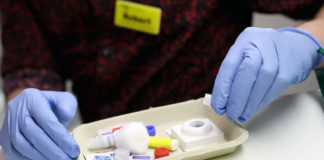Schools and districts play an essential role in supporting the needs of the whole child. Schools have the opportunity to provide a variety of protective factors in the lives of students. This toolkit is designed to explore the social, emotional and behavioral considerations schools and districts may reflect upon. The following topics are included in the toolbox:
Building and Sustaining Relationships
Positive school climate starts with positive relationships. Taking time to build meaningful relationships with students increases feelings of student safety, sense of belonging and focus on the academic environment.
The following are ways schools can maintain connectedness and a positive school climate:
- Sense of Community: Create a school and classroom environment that shows each member serves an important role.
- Positivity: Prioritize uplifting staff and students by sharing positive actions and behaviors through announcements, social media posts, newsletters and bulletin boards.
- Summer Contact: Offer connection opportunities during the summer months so students can connect with peers and staff.
- Build Familiarity: Help young children get familiar with their new environment with pictures, social stories, videos of the building or meet and greets with teachers.
- Belonging Routines: Create a classroom motto, song or chant that is repeated at the beginning or end of class every day.
- Relationship Building: Provide an outlet for staff and students to share about their personal lives through show and tell, pictures, stories or virtual tours.
- Shared Project: Complete a class project together to encourage collaboration and communication.
Resources for FOSTERING CONNECTIONS
The following are additional resources that support the establishment of trusting relationships:
Adult Self-Care
As schools and districts focus on supporting students, it is equally important for adults to focus on their own self-care and well-being. As school personnel prioritize their own self-care, students may observe and follow this lead. Districts and schools can ensure school personnel have regularly scheduled time for networking, social connections and support. School personnel cannot effectively support students if they are stressed or burned out.
To start, here are some ideas for self-care:
- Set boundaries by creating and sticking to a schedule, saying “no” when feeling overburdened and asking for space or help when needed.
- Recognize and acknowledge feelings.
- Recognize what is and is not within one’s control.
- Focus on the positive. Keep a gratitude journal.
- Practice self-care throughout the day by getting enough sleep, eating healthy, drinking plenty of water and having movement breaks.
- Use coping strategies such as mindfulness to help reduce stress.
- Ask for support from coworkers and administration.
- Complete personal pulse checks. Regularly stop and take stock of what is working and what isn’t, then make adjustments.
ADULT SELF-CARE RESOURCES
The following are additional resources that support adult self-care:
Building Resiliency through Social and Emotional Learning
Social and emotional skills allow staff and students to support each other. Facing a challenging experience and moving through it increases confidence and builds resiliency. School personnel play an important role in helping children recover from stressors and becoming more resilient.
Social and emotional learning teaches students skills such as self-awareness, emotional regulation, flexible thinking, relationship building and responsible decision-making. Developing these skills is an important part of meeting the needs of the whole child and supports their abilities to adapt . Many schools in Ohio are implementing social and emotional programs and curricula to teach these skills to students. Ohio’s Birth through Kindergarten Entry Learning and Developmental Standards and K-12 Social and Emotional Learning Standards provide helpful information and resources for schools that wish to improve their existing efforts or those starting the process.
Social and emotional learning and resiliency-building initiatives are supported by Ohio’s Prevention Education and Student Well-being Supports. Districts have been partnering with their local educational service centers and alcohol, drug and mental health boards to assess prevention needs and provide evidence-informed prevention education services for all students in all grades. Prevention education aims to build resiliency and reduce risky behaviors, including substance use, suicide, bullying and other harmful behaviors. Social and emotional learning and prevention education initiatives help students develop coping skills and make healthy decisions. Information on Ohio’s prevention education initiatives can be found here.
The following social skill activities can help students overcome existing stressors:
- Coping skills: Teach, model and practice coping skills to support self-regulation (deep breathing, progressive relaxation, physical activity, drawing or writing).
- Reframe and empower: Assist students with reframing negative thoughts into empowering statements. First, validate the child’s feelings, then offer a different perspective. For example, a student may say, “I can’t play football with my friends at recess. This is the worst. I hate school.” Staff validate the feeling and reframe. “It sounds like you miss playing football with your friends. That’s frustrating. This is a great opportunity to learn a new game or hobby. I wonder what else you would really like?” Keep in mind, some children will express negative feelings through behavior and may not be able to verbally express their feelings.
- Show gratitude: Create gratitude journals, jars or collages where students identify the positive things in their lives. This can be done as a class wide project or as individual projects.
- Relationship building: Build relationships and connections with students.
- Reflection on past experiences: Have students identify a previous challenge and how they overcame it. Point out the skills they used to persevere.
- Teachable moments: For young children, identify challenges in the moment as “teachable moments.” For example, a child exhibits frustration and the teacher acknowledges and validates the child’s feeling in the moment and supports the child in problem-solving.
- Book reflection: Use book characters to discuss challenges and how the characters overcame the challenges.
- Examples in history: Facilitate class activities that research historical times of challenge and crisis. Discuss how people during that time may have felt and how they overcame the situation.
SOCIAL AND EMOTIONAL LEARNING RESOURCES
The following are additional resources that support social emotional learning:
Supporting Behavior
Sometimes educators may notice significant changes in student behavior in response to stressors. Young children do not have the cognitive ability or verbal skills to understand and articulate strong emotions. Early childhood staff may see behaviors such as crying, aggression, helplessness and difficulty with separation. Similarly, older children and teenagers may struggle to identify, express and manage the complex emotions they are feeling.
It is common for individuals to compensate by demonstrating behaviors that provide an increased sense of control. For some students, this may be demonstrated through externalizing behaviors such as refusal to attend and participate in school, defiance or verbal and physical outbursts. Students may demonstrate internalizing behaviors such as withdrawal, changes in sleeping and eating patterns and increased physical complaints (headaches, stomach aches). Teachers may see changes in students’ abilities to focus and remain on task.
The Positive Behavioral Interventions and Supports (PBIS) framework provides the foundation for planning and implementing activities throughout this resource. Schools implementing PBIS demonstrate improved relationships and school climate, as well as reductions in behavior disruptions, office discipline referrals and out-of-school discipline. Ohio recognizes high-quality implementation through the Ohio PBIS Recognition System. Schools are eligible to receive awards at the bronze, silver or gold level of distinction. Further information about the PBIS Recognition System and award-winning schools that are available for networking can be found here.
Districts and schools can receive PBIS training through state support teams (SSTs) or educational service centers (ESCs). These entities will continue to expand their current PBIS training menus as a part of Ohio’s School Climate Transformation Grant.
TEACHING BEHAVIOR EXPECTATIONS
At the start of the school year, school staff use the first few weeks to teach, model and practice the schoolwide expectations, rules and routines. These practices and routines then become habits throughout the year.
In addition to teaching the typical behavior expectations, staff can:
- Promote familiarity with school routines;
- Review their PBIS Implementation. Schools implementing PBIS should review and update their behavior matrix;
- Set clear expectations. Review expectations, such as being respectful or being kind, and how these expectations can be used for the prevention of harassment, intimidation and bullying; and
- Recognize good behavior. Acknowledge appropriate behavior frequently at the start of the year, and transition to intermittent acknowledgement as the year progresses. Depending on the location of school, adaptations may need to be made in how acknowledgement and reinforcement is provided.
TIERS OF SUPPORT TO ADDRESS STUDENT NEED
Providing tiered behavior and academic supports, known as a Multi-Tiered System of Support, is needed to address each child’s unique needs. School teams should consider how they will gauge the needs of all students and create decision rules for determining when additional supports are needed. When challenging behaviors arise, looking at the “why” behind the behavior, staying proactive and addressing the student’s needs rather than immediately reacting to behaviors with a disciplinary measure are key for creating safe and supportive environments.
School staff will benefit from professional development on behavior supports, the impact of stress and trauma on behavior and learning, and how to recognize, respond and refer for mental health needs. Schools can collaborate with mental health agencies to provide services for students and consultation for staff regarding behavior supports and interventions in the classroom.
DISCIPLINE PROCEDURES
While it is important for school teams to address behavior concerns, the focus should be on helping students understand behavior missteps and reinforcing proper behaviors. A goal should be to keep students in the classroom and in school as much as possible. School teams benefit from creating a continuum of discipline practices that avoid exclusionary approaches such as suspension and expulsion. Alternatives to suspension and expulsion may include interventions such as restorative practices and mentoring programs, both of which focus on relationships and re-engaging students.
SAFETY AND USE OF RESTRAINT
Teams should plan for safety concerns where a student is at risk of harming him or herself or someone else. To limit the use of physical restraint as much as possible, staff should attempt to isolate the concern by removing other students and staff and use de-escalation techniques. Physical restraint should only be used as a last resort. School teams should consider training staff in de-escalation techniques at the start of the school year to prepare staff to address unsafe behaviors. See the Ohio Department of Education’s resources on restraint and seclusion here.
BEHAVIOR SUPPORT RESOURCES
The following are resources that support effective behavior support practices:
Trauma-Sensitive Practices
Understanding students have various experiences is essential to meet students where they are. It is the responsibility of school personnel to create a building that feels safe for all students and staff.
PROTECTIVE FACTORS AND RELATIONSHIPS
Protective factors reduce the impact of traumatic experiences. One of the most influential protective factors in a child’s life is a supportive, healthy relationship with a trusted adult. Relationships between students and staff and among peers should be developed and nourished throughout the year. It is important to create connections through social and emotional learning activities and focus on healing through relationships early in the year to help students feel safe from the start.
Solid trauma-informed approaches incorporate a strengths-based approach. Identifying and emphasizing a student’s strengths, such as the protective factors in his or her life, will assist with addressing any needs the student may have.
CREATING SAFE ENVIRONMENTS
It is important for all students to return to school in a safe and predictable environment. The PBIS Tier I practice of teaching behavior expectations can help create predictable environments (see Supporting Behavior). Providing healthy outlets for students also can assist with setting up a safe environment. For example, teachers may choose to introduce fidgets or other sensory objects within their classrooms.
When challenging behaviors arise, looking at the “why” behind the behavior, staying proactive and addressing the student’s need rather than immediately reacting to behaviors with a disciplinary measure are key to creating a safe, trauma-sensitive environment.
ADULT TRAUMA
As important as it is to be sensitive to trauma in students, it is equally as important to be aware that adults — educators, school personnel and caregivers — also have been impacted by trauma. Adults should practice self-care (see Adult Self-Care) to provide the best care to students. As educators and school personnel work with families, it is important to consider the adults in the home may have experienced trauma.
Schools can find ways to support families in managing stress and providing safe environments for students everywhere. Providing parents and caregivers with tips or resources to practice their own self-care and wellness, while also structuring a safe space for learning, are key to helping each student.
Educators should empower families through a strengths-based approach and take preventative measures for increasing safety even when students are not with them. The Preventing Abuse and Neglect section on the Ohio Department of Education’s website may be a helpful resource for educators to help keep students safe.
SUPPORTIVE ACTIVITIES
Below are some ideas to consider for implementing trauma-sensitive practices in the school:
- Professional development: Beginning at the start of the school year, provide ongoing professional development for staff about stress and trauma.
- Self-care space: Have a staff self-care space in the break room with items for staff and a process for teachers to support each other emotionally while at work.
- Needs survey: Conduct a needs survey for students and staff to gain a sense of what may need to be addressed.
- Trauma response plan: Consult with school mental health staff or work with community partners to make a plan for how to address trauma in the school.
- Fidgets: Create a list of budget-friendly fidgets and prepare staff and students for how these can be used effectively in the classroom.
- Relationship building: Facilitate activities that nurture relationships between students and adults and help create new trusting relationships with students.
- Mindfulness: Facilitate activities that teach skills like mindfulness. Breathing exercises, yoga or meditation can be taught and practiced as a standalone lesson or incorporated as part of another lesson. Practice these skills and re-teach as necessary.
- Self-calming: Facilitate lessons that teach students self-calming strategies. Practice these strategies and provide feedback to students.
- Nutrition and exercise: Create opportunities to teach and explain how nutrition and exercise directly impact the brain and mental health.
- Journaling: Have a journal available for each student and start the day with a journal entry. Students can have the option to share or not.
- Family Pictures: Allow each student to bring picture of a caregiver to keep in his or her book bag for the day.
- Group processes: Work with a school counselor on setting up groups that may address trauma needs presented by students needing additional supports (Tier II).
- Allow breaks: Allow opportunities for students to take breaks when needed from challenging tasks. When it is time for them to start again, help the students make plans. Providing one to three “break cards” may be helpful when implementing. Students may use the break cards for water breaks, chatting with a trusted adult or time to stretch, to name a few. Be sure to set guidelines for how break cards may be used.
- Classroom jobs: Allow opportunities for helping and classroom jobs. Jobs can rotate between students, such as line leader or paper passer. If a child has a relationship with a trusted adult, such as a cafeteria staff member, allow the student to help that person on a regular basis.
- Schedules: Have structure and posted schedules that create predictability and consistency. For some students, schedules should include visuals and be posted at eye level.
- Trusted adult interaction: Allow for children to visit trusted adults if time and schedules allow. Give students opportunities to write notes to trusted adults (home or school) and have the option to deliver these notes.
- Counseling referrals: Plan with staff to discuss any counseling referrals that may be needed. Have a shared process and plan in the building for how and when students will be referred.
- Calm kit: Create individualized calm kits with children where they can have things like a fidget, putty, paper and pencil, pipe cleaners or other things they can use to calm themselves or help regulate.
- Classroom environment: Set up the classroom in a manner that is aware of sensory needs, such as dimmed lighting, reducing smells and calm music
TRAUMA-SENSITIVE PRACTICES RESOURCES
The following are additional resources that can support trauma-sensitive practices:.
Suicide Awareness and Prevention
Suicide is the second leading cause of death among adolescents 15-19 years old (Centers for Disease Control, 2020). Schools and districts should provide information for families to connect with mental health resources, including Ohio’s CareLine. Additionally, they should create comprehensive protocols for suicide prevention, intervention and postvention. In challenging times, youth most frequently seek support from their peers. Suicide prevention models that include training for youth and strengthen peer-to-peer identification and notification have proven successful.
School staff should be prepared to recognize the warning signs of suicide, respond by offering support and refer for medical or mental health assessment and intervention when needed. The information below is a helpful reminder of these steps but should not take the place of more in-depth training.
Recognizing Warning Signs of Suicide. The following are some of the most common warning signs reflected in student behaviors:
- Expressing feelings of hopelessness or having no reason to live. These could be comments such as: “I don’t even know why I’m here, I never asked to be born,” or “things are never going to get better.”
- Talking about feeling trapped or not being able to identify possible solutions to major stressors, problems or concerns.
- Changes in sleeping and eating patterns (too little or too much).
- Withdrawing from others.
- Demonstrating risky, self-destructive or self-harming behaviors.
- Talking about being a burden to others.
- Talking about wanting to die or killing themselves.
Responding to Suicidal Comments: These are initial responses adults can take to respond to warning signs:
- Note the warning signs noticed and express concern for the student’s well-being.
- Emphasize the student’s worth.
- Ask the student to say more about his or her feelings.
- Do not dismiss his or her feelings or perceived problems.
- Ask the student if he or she is thinking of killing him or herself or suicide.
- Let the student know help is available. Share information about local counseling supports, the Ohio CareLine, National Suicide Prevention Hotline or Ohio Crisis Textline (see Help Lines below).
Referring for Medical or Mental Health Assessment and Intervention
- If a student is expressing suicidal statements, the staff should follow referral protocols established for the school and district.
- Inform the parent or guardian of the concerns and available resources.
If you think a youth is at immediate risk of suicide,
call 911 immediately for help.
SUICIDE AWARENESS AND PREVENTION RESOURCES
Below are resources to support districts and schools with suicide prevention and intervention.
HELP LINES
- Ohio Crisis Text Line: Text the keyword “4hope” to 741 741 to be connected to a trained Crisis Counselor within five minutes.
- Ohio CareLine: 1-800-720-9619 — The Ohio CareLine is a toll-free emotional support call service created by the Ohio Department of Mental Health and Addiction Services and administered in community settings. Behavioral health professionals staff the CareLine 24 hours a day, seven days a week. They offer confidential support in times of personal or family crisis when individuals may be struggling to cope with challenges in their lives. When callers need additional services, staff will provide assistance and connect callers to local providers.
- National Suicide Prevention Lifeline: 1-800-273-8255
- The Trevor Project Get Help Now: The Trevor Project is the leading national organization providing crisis intervention and suicide prevention services to lesbian, gay, bisexual, transgender, queer and questioning youth. Those needing help can contact the TrevorLifeline at 1-866-488-7386; chat online through the website; or text Start to 678-678.
Questions
Questions regarding the topics in this document can be sent to the Office of Whole Child Supports at WholeChild@education.ohio.gov.
Visit these websites for additional resources:
Last Modified: 8/13/2021 10:47:56 AM









